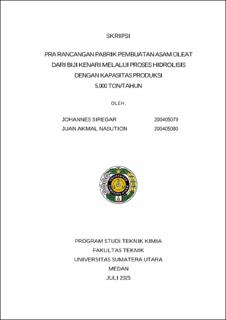Prarancangan Pabrik Pembuatan Asam Oleat dari Biji Kenari melalui Proses Hidrolisis dengan Kapasitas Produksi 5.000 Ton/Tahun
Preliminary Design of a Factory for The Production of Oleic Acid From Walnut Seeds Through Hydrolysis With a Production Capacity of 5.000 Tons/Year

Date
2025Author
Siregar, Johannes
Nasution, Juan Akmal
Advisor(s)
Trisakti, Bambang
Sidabutar, Rivaldi
Metadata
Show full item recordAbstract
Indonesia is a country rich in natural resources, one of which is its significant potential as a producer of cashews. Cashews have seeds that contain vegetable oil rich in oleic acid, which has many uses in the oleochemical industry, health, and energy sources. Currently, Indonesia's demand for oleic acid is still met through imports, making the establishment of an oleic acid plant based on cashew seed oil hydrolysis a strategic opportunity. This preliminary plant design is planned to have a production capacity of 5,000 tons per year and operate for 330 days per year. The raw material used is 4,498.695 kg/hour of walnuts. The processes involved in this preliminary design include raw material preparation, oil extraction, oil purification, oil hydrolysis, and fatty acid crystallization. The oil hydrolysis process takes place in a hydrolysis reactor operating at a temperature of 250°C and a pressure of 50 atm for 1 hour to obtain fatty acids and glycerol. The fatty acids are then separated based on their freezing points during the crystallization process. The plant is planned to be built in Tidore Islands, North Maluku, on a land area of 18,161 m². The planned business entity is a Limited Liability Company (LLC) with a linear organizational structure and 171 employees. The economic feasibility analysis shows an investment capital of Rp. 959,694,506,445, production costs of Rp. 913,428,316,256, annual sales revenue of Rp. 1,146,331,243,721, and net profit of Rp. 177,122,676,337 with a profit margin (PM) of 19.81%, return on investment (ROI) of 18%, break-even point (BEP) of 32.06%, payback period (POT) of 5.42 years, return on network (RON) of 30.76%, and internal rate of return (IRR) of 20.34%. Based on the economic results, it can be concluded that this oleic acid production plant is feasible to establish.
Collections
- Undergraduate Theses [1239]
